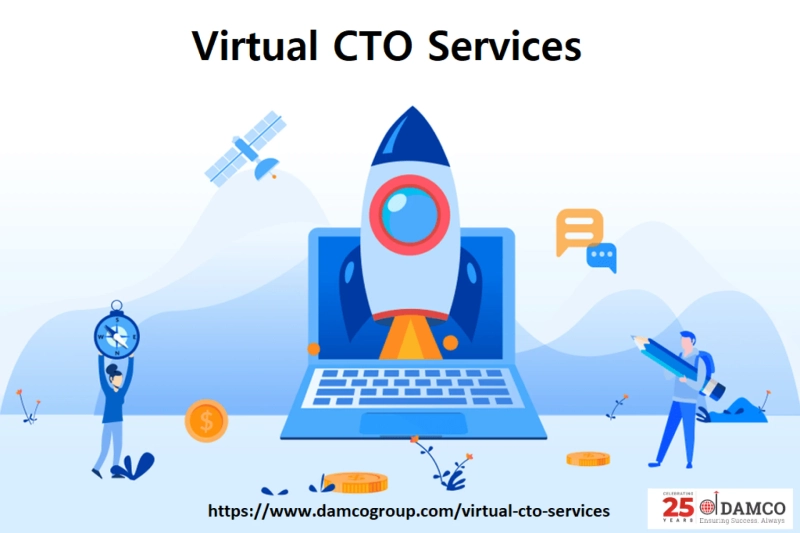The typical CTO (Chief Technology Officer) position and responsibilities have substantially changed over the past few years and remain to be transforming. A CTO is meant to be the professional who took care of the enterprise’s tech requirements.
However, the advent of digital disruption has transformed the role of technology and the significance of CTO responsibilities. When enterprises adapt to new situations, CTOs should direct the adoption of new operating methods and infrastructure. This has intensified the necessity to hire Virtual CTO experts, who provide remote-ready services and enable enterprises to scale more quickly.
By leveraging Virtual CTO services from a recognized firm, organizations can acquire the expertise similar to a full-time CTO without getting concerned about the additional costs of hiring. Meaning that hiring a Virtual CTO advisory is a more cost-effective option than hiring full-time CTO experts. At present, many IT service providers offer Virtual CTO as a service for start-ups, entrepreneurs, and corporates to seamlessly set up technology vision and accelerate growth.
Introduction to Virtual CTO
A vCTO or Virtual Chief Technology Officer is an expert within an organization, who administers the organization’s infrastructure and technology, and formulates related strategies for growth. A Virtual CTO must possess strong business knowledge to align technological decisions with the organization’s objectives.
A regular full-time CTO performs similar responsibilities. But a Virtual CTO makes a long-run commitment to enterprises. Virtual CTOs with a rich awareness of tech trends help organizations map out concepts for new products and services, and provide tech-powered solutions for customers. In a recent report, around 67% of companies mentioned that hiring CTOs through the ‘Virtual Enterprise’ model enables them to optimize their business’ technical performance and standards. By hiring these experts, enterprises can easily resolve many existing complexities and ensure complete success.
What Does A Virtual CTO Offer?
- Consulting- Providing expertise on the business’ whole tech infrastructure
- Infrastructure- Exploring the methods to enhance business infrastructure
- Strategy- Creating roadmaps to ensure all the decision-makers and teams in an organization knows its future tech path
- Investments- Reducing redundant operational costs, guaranteeing best-value spending, and building strategies for better financial performance
- Security- Adhering to cyber best practices and ensuring better IT security management
5 Key Steps Followed By Virtual CTOs To Accelerate Business Growth
Establishing Tech Vision
A Virtual CTO helps create a technology vision for enterprises through which strategic decisions can be taken. The tech vision includes understanding the project’s needs, investigating and assessing various technologies, and determining appropriate technologies to be used. A Virtual CTO shares the new technical vision with every team in an organization and ensures that everyone is aware of it. They can effectively create a tech strategy blueprint by considering the business goals and scalability.
Forming & Organizing Technical Team
Virtual CTOs help enterprises in hiring or setting up the process to discover the right applicants and associates for projects. They oversee all the elements of the enterprise’s technical operations. They help tech teams in choosing the right mix of architecture, programming language, libraries, frameworks, and tools for the project. Virtual CTOs also guarantee that the technical team’s goals are in line with the enterprise’s overall strategy. In short, they can build and monitor tech teams and ensure the success of every project.
Moreover, Virtual CTOs play a major role in apportioning or recommending the IT budget for enterprises. With the support of an on-demand Virtual CTO, enterprises can frame KPIs to evaluate technical performance and make presumptions accordingly.
Assisting CFOs With Fundraising Policy
A Virtual CTO enhances the connection between the company and the technology by helping them make planned and cost-effective decisions. This will drive the quality of the project and lead to greater ROI.
Virtual CTOs focus on utilizing technology to develop the business by tapping into new markets, and partnerships or identifying an effective process within the present business model. It has been estimated that around 35% of companies rely on Virtual CTOs in making partnerships and financial decisions. A Virtual CTO acts not only as the enterprise’s tech voice but also helps promote investments and organizes vendor relationships by teaming up with in-house CFOs.
Implementing Enterprise-Grade Practices
A Virtual CTO enables organizations to implement industry best practices during product development. This way organizations can offer incredible solutions to end-users. They ensure various standards like PCI, HIPAA, and GDPR are used during product development to maintain better compliance and acquire competitive benefits. They also bring on the best quality analysis practices to deliver a quality product. A Virtual CTO can effectively verify the project’s acceptance criteria and make sure that the best solutions were developed to fulfill end-user needs.
Identifying Project Issues
The supervision of a Virtual CTO can help enterprises discover several issues in the project. They can effectively validate the plan prepared by the team and offer insights into the pitfalls and challenges that can be encountered during product development. However, they also take measures to reduce issues, and costs and enhance project productivity.
Benefits of Hiring a Virtual CTO
Easy Analysis of Business Landscape
At the start, a Virtual CTO precisely analyzes the business model, infrastructure, and internal resources, and provides a clear image of the organization’s productivity levels. After detailed analysis, a Virtual CTO can help enterprises find the right tech stack that aligns with the budget and scope of the company. Besides, a Virtual CTO can help educate an organization’s internal workforce on where they can implement innovative technologies, and how to take advantage of modern tools. The right Virtual CTO can act as a push to organizations by providing online technical support and solutions.
Organize Business Objectives
As stated before, the Virtual CTO plays a key role in mission-critical tech operations that will escalate the company\'s performance to the next level. They interact with internal management members and formulate the best technology strategy for enterprises to improve the user experience. The creation of a strategy includes describing and establishing the standards for future necessities. Hence, Virtual CTOs with deep knowledge of technology investments can keep enterprises systematized and aligned with business goals.
Cost-Effectiveness
Hiring a full-time CTO can especially impact the enterprise budget since they are one of the most highly-paid professionals in the industry. Hence, employing a Virtual CTO advisory would be helpful because organizations can gain tech insights, discover the right tech stack for their development, and provide technical support online. This way, enterprises can substantially cut down the transfer costs and all other difficulties related to hiring a full-time CTO functioning on their premises.
Smart Decision Making
Many organizations still disregard the interests/importance of the end-users when it comes to selecting and employing new technologies. Certainly, this will bring down the capability of enterprises to surpass competitors in the market. Hence, by hiring the right Virtual CTO advisory service provider, enterprises can align their tech strategy with real-time user and business objectives. This approach will boost business productivity, generate greater profits on suitable technology investments, and allow enterprises to beat the competition.
Summing Up
Enterprises need to remember that retaining a full-time CTO will always be more expensive than employing a Virtual CTO. However, there are some features to be considered by enterprises before spending on CTO services. For instance, the living costs of a Virtual CTO will impact the salary that the enterprise can afford. Another aspect that businesses have to consider is the range of services that Virtual CTO can deliver. However, a majority of Virtual CTOs in the business ecosystem have expertise in implementing advanced technologies that accelerate IT, data security, data and analytics, user experience, and many others.
0


